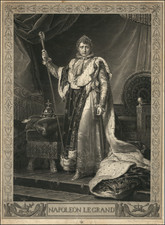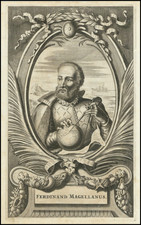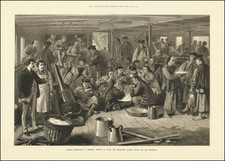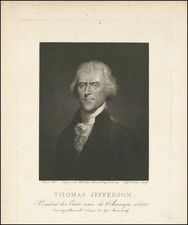This etching by Wenceslaus Hollar, dated 1640, features a detailed portrait of Sir Thomas Wentworth, 1st Earl of Strafford. The portrait depicts Wentworth in full armor, facing slightly to the right, with a stern expression. He holds a baton in his right hand, and his helmet rests on the ground beside him. The background shows a military camp with tents and soldiers, indicating his significant military and political roles.
Sir Thomas Wentworth, 1st Earl of Strafford, was a significant political figure in early 17th-century England, serving as Lord Deputy of Ireland and later as a key advisor to King Charles I. His strong-arm tactics in governing Ireland and his staunch support of royal prerogative made him a controversial figure. Wentworth's career culminated in his impeachment and execution by Parliament in 1641, events which were critical in the lead-up to the English Civil War.
This etching by Wenceslaus Hollar, based on a painting by Anthony van Dyck, captures Wentworth in his prime, adorned in the armor that signifies his military and political authority. The detailed rendering by Hollar highlights the craftsmanship and the importance of the sitter, while the background details provide context to Wentworth's role as a military leader.
The inscription below the image reads:
"Sr THOMAS WENTWORTH KNIGHT EARLE OF STRAF
forde, Viscount Wentworth, Baron Wentworth of Wentworth
Woodhouse, Newmarch Oversley and Raby. Lord Lieutenant
Generall, and Generall Governour of the Kingdome of Ireland,
Lord President of the Councell established in the North parts of
England. Lord Lieutenant of the County and City of Yorke, and
one of his Ma: most honourable privy Councell."
Wenceslaus Hollar, born on July 23, 1607, in Prague, was a prolific and accomplished Bohemian graphic artist of the 17th century.
Known to German speakers as Wenzel Hollar and to Czech speakers as Václav Hollar, he is celebrated for his masterful engravings and etchings. The turmoil of the Thirty Years' War, particularly the Sack of Prague, devastated Hollar's family, leading him to abandon his initial path towards a legal career and instead pursue the arts. His earliest surviving works date back to 1625 and 1626, showcasing the influence of Albrecht Dürer. In 1627, Hollar apprenticed under the esteemed engraver Matthäus Merian in Frankfurt, marking the beginning of his illustrious career.
During the early 1630s, Hollar resided in Strasbourg, Mainz, and Koblenz, capturing the essence of the Middle Rhine Valley through his depictions of towns, castles, and landscapes. In 1633, he moved to Cologne, where his talent began to attract significant attention. It was here, in 1636, that he caught the eye of Thomas Howard, the 21st Earl of Arundel, a renowned nobleman and art collector. Hollar joined Arundel on diplomatic missions to Vienna and Prague, and in 1637, he accompanied the Earl to England.
Upon settling in England, Hollar became part of Arundel's household, though he did not work exclusively for the Earl. He continued to create independently and for various authors and publishers. Following Arundel's death in 1646, Hollar commemorated him with a print designed by Cornelius Schut. Hollar's remarkable "View of Greenwich," published by Peter Stent, exemplified his early work in England and set a precedent for his meticulous and expansive cityscapes.
The English Civil War significantly impacted Hollar's career, although he remained productive. He withstood the siege of Basing House alongside royalist artists like Inigo Jones and William Faithorne. Despite the adversity, Hollar's output was prolific during this period, with numerous plates dated 1643 and 1644. Following his capture and subsequent escape during the siege of Basing House in 1645, Hollar relocated to Antwerp, where he reconnected with Arundel and produced some of his most acclaimed works, including cityscapes, seascapes, and intricate studies of nature.
In 1652, Hollar returned to London, continuing his work with notable publishers and illustrating various significant texts, including Ogilby's Virgil and Homer, Stapylton's Juvenal, and Dugdale's Warwickshire, St Paul's, and Monasticon.
Following the Great Fire of London in 1666, Hollar produced his famous "Views of London," capturing the city's devastation and subsequent rebuilding. In 1668, King Charles II commissioned him to document Tangier's town and forts. His return voyage included a notable naval engagement, which Hollar later etched for Ogilby's Africa. Hollar continued to produce well-regarded works until his death on March 25, 1677, in London, where he was buried at St Margaret's Church, Westminster.
Hollar's legacy endures through an extensive body of work, including some 400 drawings and 3000 etchings. His plates, numbering around 2740, encompass a vast array of subjects, from topographical views and portraits to intricate depictions of nature and architecture.
Collections of Hollar's work are held in prestigious institutions such as the British Museum, Windsor Castle, the National Gallery in Prague, and the Virginia Museum of Fine Arts. His contributions to graphic art are celebrated in catalogues by George Vertue, Gustav Parthey, and Richard Pennington, with a comprehensive catalogue published in the New Hollstein German series. Hollar's work remains accessible through digital collections, notably at the University of Toronto and the Folger Shakespeare Library.
The Wenceslaus Hollar Secondary School of Art in Prague honors his name, ensuring that his artistic legacy continues to inspire future generations.











![[Jonah Negotiating His Embarkation] Quid demens latebras circumspicis alterum in orbem. Si fugirs Dominum, non tamen effugies. Cui tellus paret, summus cui militat aether, Non parere putas huic etiam Oceanum](https://storage.googleapis.com/raremaps/img/small/85070.jpg)
![[Portrait of Louis XV as a child] Ludovicus XV. Franciae et Navarrae Rex Natus 15 Febr. Anno 1710.](https://storage.googleapis.com/raremaps/img/small/95867.jpg)

